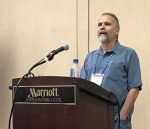
CEMML archaeologists and their federal and academic partners convened the symposium “CRM [cultural resource management] archaeology on federal lands: new contributions and unique management strategies” at the 2018 annual meeting of the Society for American Archaeology, which was held in Washington, D.C. in April. The nine presentations in the symposium explored the creative ways in which CEMML archaeologists around the country are managing and protecting archaeological sites in the face of decreasing budgets and changes in government priorities. For example, the cultural resources management team at Fort Wainwright, Alaska, developed and implemented a plan to minimize adverse effects to archaeological sites within the boundaries of extensive off-road training exercises. The symposium also addressed the contributions of CEMML archaeologists to historic and prehistoric narratives nationwide. For instance, presenters described analyses of artifacts at Fort Riley, Kansas, that elucidated potential land uses throughout the Archaic (~8000–1000 BCE), Woodland (~1000 BCE to European contact), and Late Prehistoric (1800–150 BCE) periods. Presentations were followed with a synthesis by Jim Zeidler, CEMML Associate Director Emeritus, and Jeffrey Altschul.